JOEL SARTORE
Joel Sartore is a photographer, a fellow of the National Geographic Society and the founder of Photo Ark, an international multi-year project in association with National Geographic to document the approximately 15,000 species living in captivity.
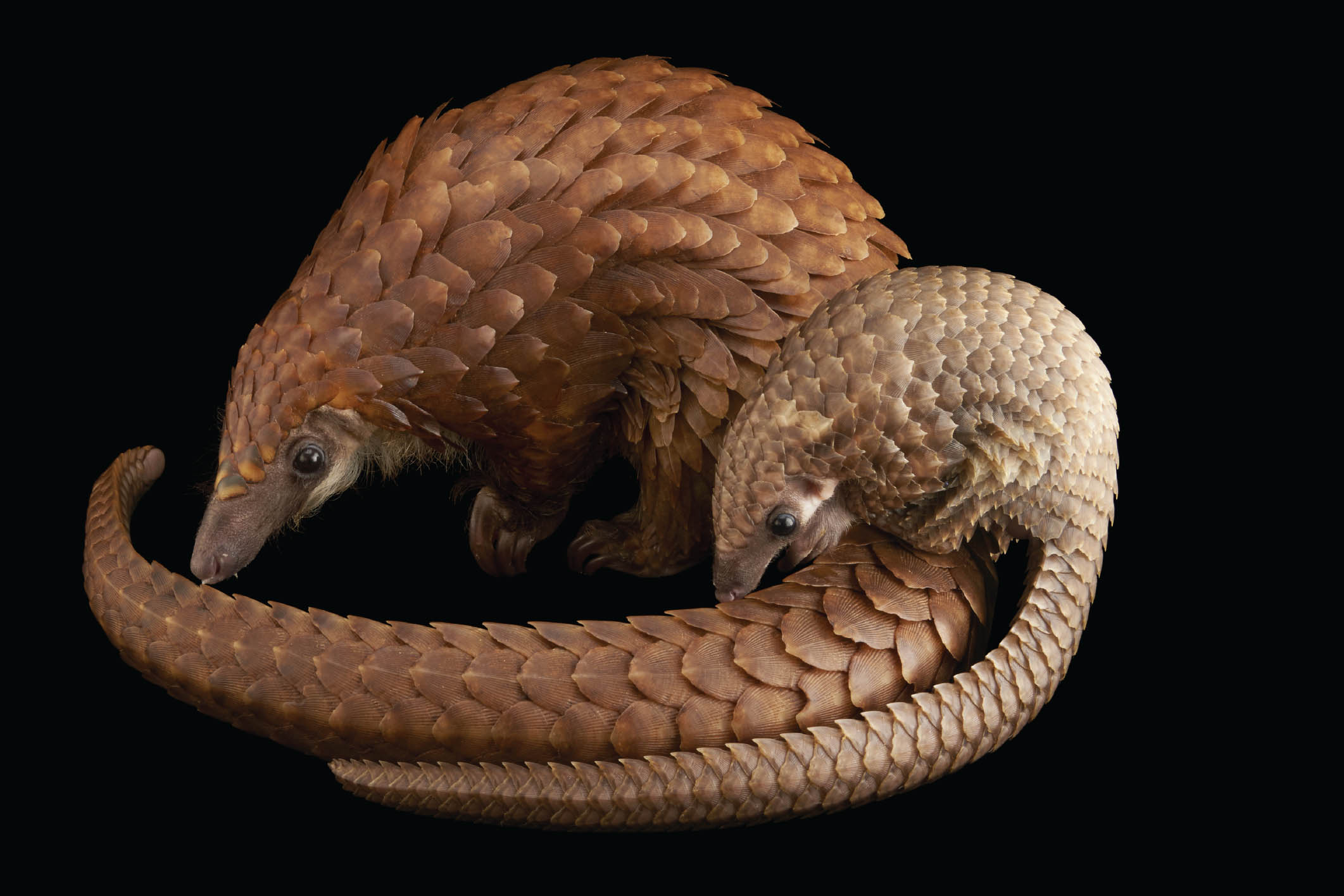
A young white-bellied pangolin clings to her mother’s back at a facility in Florida, USA. This captive-born baby was a first in captivity, an important step in protecting pangolins from extinction due to poaching. The demand for pangolin is driven by the false belief that their protective keratin scales have curative properties.
I was born in Ponca City, Oklahoma, where my Dad was an oil refinery chemist. We moved to Nebraska when I was two years old so that my father could work for a company that made growth implants for cattle and hogs. I grew up in a middle-class town called Ralston, on the edge of Omaha. After high school, I went to the University of Nebraska [Lincoln], where I had three instructors who were crucial: two taught writing and one taught photojournalism. The photography instructor, George Tuck, was the first professor I’d ever met who remembered my name. On the second day of class he passed me in the hallway and said, ‘We’re expecting great things from you, Joel’. It turns out he was good with names and said that to everybody, but it worked on me – I believed him.
My love for all species is thanks to my parents. They really cared about nature and inadvertently passed this on to me. As a child I didn’t realize how special that was. My mother loved her backyard birds and flowers; even the squirrels and the rabbits interested her. It was a big deal each spring when the snow geese migrated high overhead – we would drop everything to watch them. My father took me hunting and fishing every weekend that we could get away. He used to say, ‘It doesn’t matter if we get anything or not, it’s about being out here and being together’. Some people take their kids to sporting events or shopping, but my parents took me outside.
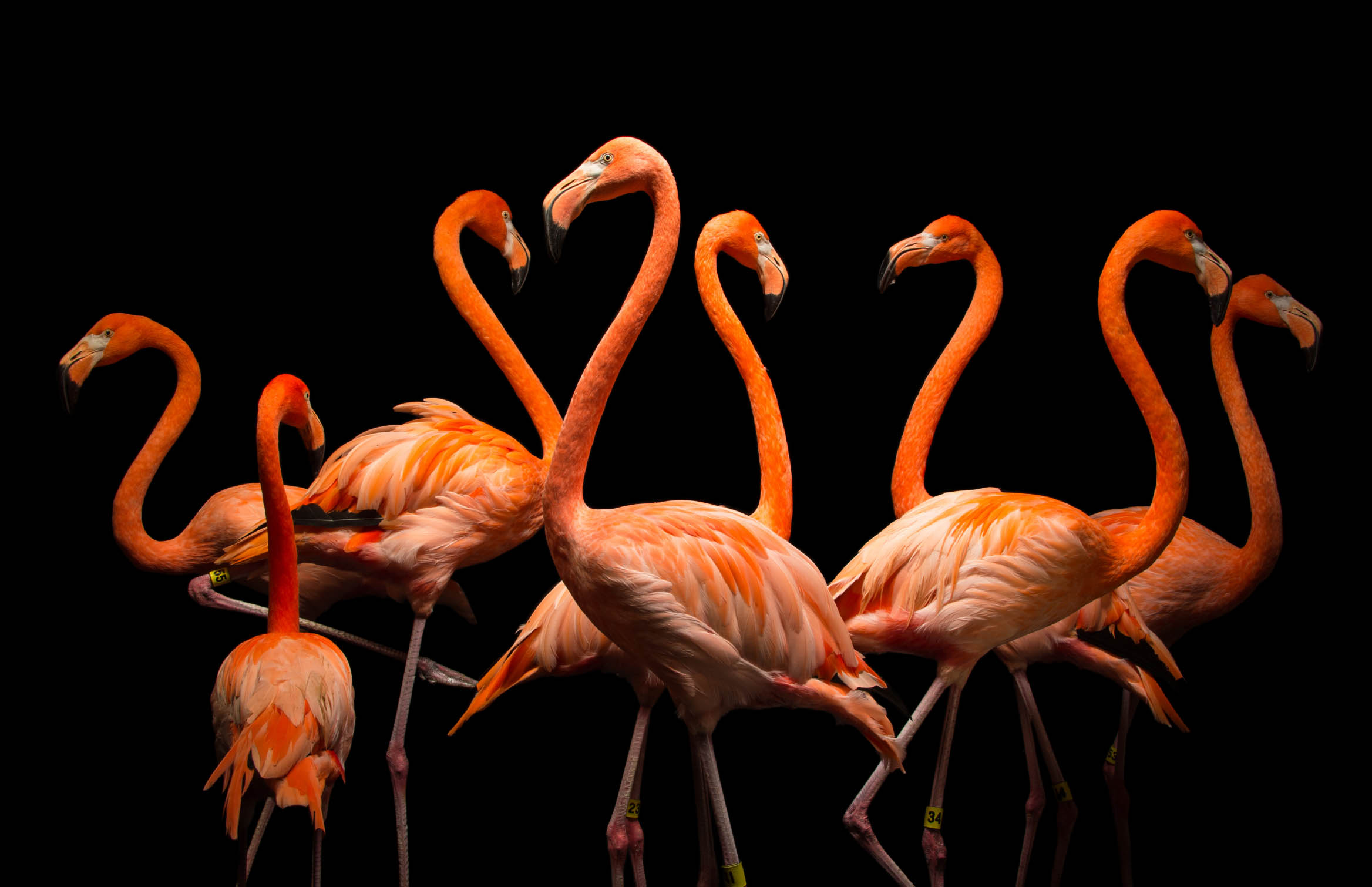
American flamingos at the Lincoln Children’s Zoo in Nebraska, USA. These graceful and striking birds have a love-hate relationship to one another; they must flock together to feel safe, but bicker and squabble constantly. The Photo Ark was started in 2006 at this zoo, which is just a mile from Sartore’s home.

A federally endangered Florida panther at Lowry Park Zoo in Tampa, Florida, USA. Named Lucy, she was among the last purebred members of her subspecies. In order to save the species from extinction, several western cougars were released into the Florida wild to improve the genetics of the wild population.
After I got my degree in journalism, I went to work at the Wichita Eagle newspaper in Kansas as a general assignment photographer. Steve Harper was director of photography and after a while he would let me do my thing. He said, ‘Look, I’ll give you one day a week to just shoot the kind of things you want to shoot, as long as you are producing photos we can run in the newspaper.’ I started really using that day, plus my weekends and eventually I got noticed through some news photography contests and caught the eye of National Geographic photographer Jim Stanfield.
Jim gave me a recommendation to send my portfolio in to National Geographic, but the interview at their DC headquarters didn’t go so well. I was nervous, hadn’t slept, it was raining, I had a splitting headache and I’d started to get a cold. My guard was down. I sat in the office of the assistant director of photography, Kent Kobersteen. It was late in the day and the hallways had these fabulous pictures – Jim Brandenburg’s white wolf jumping on the iceberg and Steve McCurry’s Afghan girl with the green eyes – and I had a portfolio with pictures of chickens, hogs and rodeo queens. I didn’t belong there.
I was sitting like a lump on his office couch and hadn’t said anything for a long time. He eventually went through his mail, then he turned off his desk light and got his coat. He had forgotten about me. I cleared my throat and he said, ‘Oh yeah, it’s time to go. By the way, why should I hire you?’ I said, ‘I don’t know, I don’t like people that much and I hate to travel.’ I was just being honest, but what I meant was, I don’t like crowds and I don’t like leaving home. He shrugged and I left, figuring that was the last time I’d ever step foot in the place. Then I got a letter in the mail two weeks later. It was on a Geographic letterhead and from Kent Kobersteen. The last sentence was, ‘We’ll be calling you, count on it’. And they have been ever since, for some thirty years now.
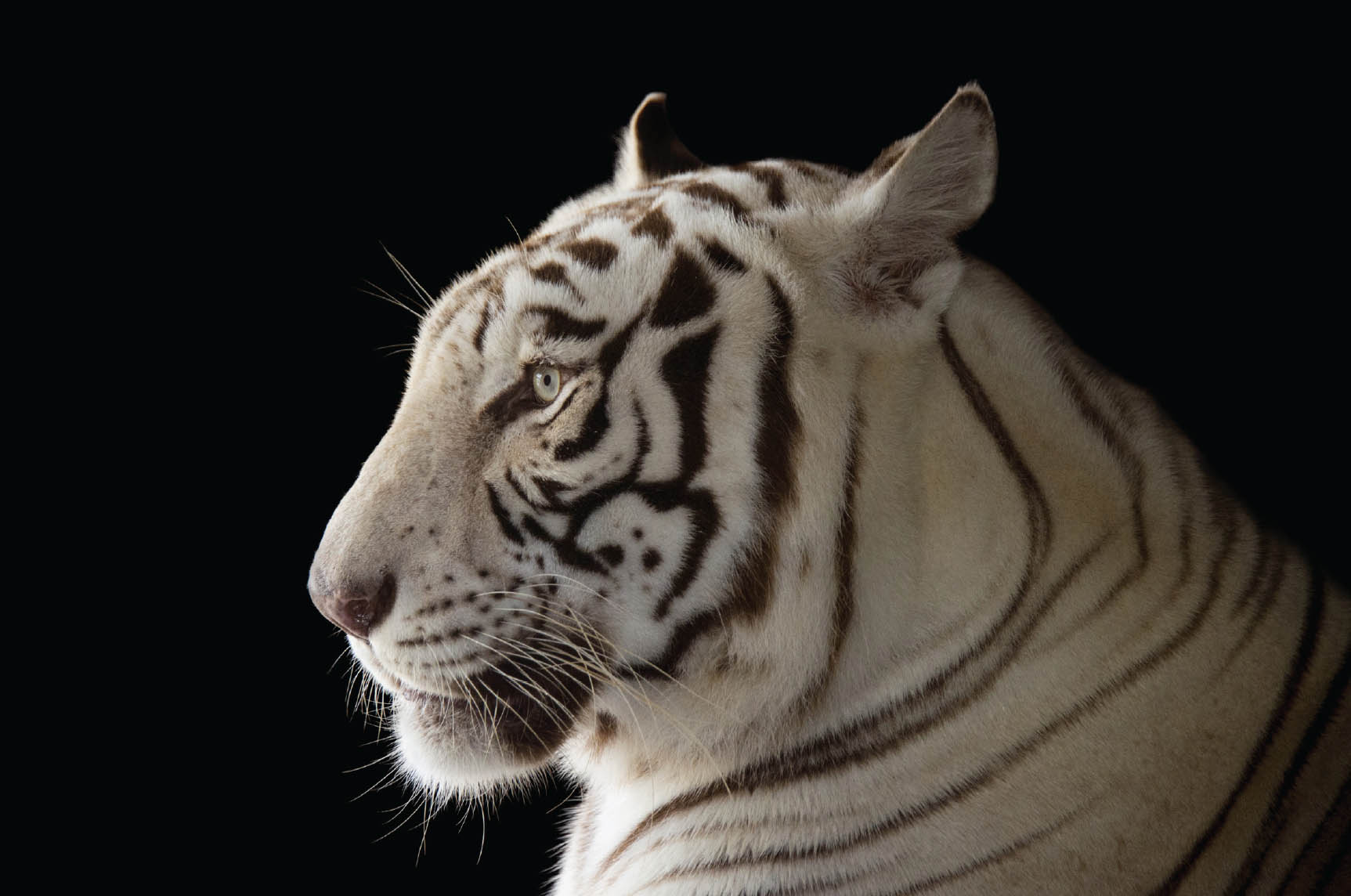
Rajah, a male white Bengal tiger at Alabama Gulf Coast Zoo, Alabama, USA. This colour pigmentation rarely happens in the wild but has been around for decades in some captive populations, much to the delight of zoo visitors.
My first assignment for them was a few chapters in a National Geographic book while I was working for the Wichita Eagle and then I got a magazine shoot and one led to the next and I kept doing those magazine shoots for about seventeen years – until my wife, Kathy, got sick. That’s when everything stopped.
*
For a long time I was a globe-trotting photographer. I worked around the world on just about every continent and shot thirty stories in seventeen years: lions taking naps in the trees in Uganda, crocodiles at waterholes in Mozambique, the Endangered Species Act in the US, a big story on America’s Gulf Coast and human interest stories; on State Fairs [agricultural shows], a feature on the Tex-Mex border, even one documenting my home state of Nebraska. And then came an important phone call.
‘When I look extinction in the eye like that, I think, “This is epic in ways I don’t understand and it’s going to eventually have very drastic consequences for humanity”.’
I’d been up on Alaska’s North Slope for several weeks and my wife said, ‘You need to come home. You’ve been gone seven weeks and I don’t want to do this anymore.’ I went home to work on my marriage and very soon after she discovered a tumour in her right breast. She was on chemo and radiation for nearly a year for breast cancer. We had three little kids at home; I’d never even changed a diaper on the youngest one. He barely knew who I was. I’d been doing all these stories for Geographic and they were successful, but I wasn’t that successful being at home.
Being a Geographic photographer is a little like being an astronaut. What are you going to do when that’s over? I had zero clue. I was worried my wife was going to die, I was worried I wouldn’t know how to raise our kids – I didn’t know how to cook, or how to really use the washing machine – and I was worried we’d lose our house, because we were paid by the day when I was in the field – and I wasn’t doing that anymore.
I had a year at home and we made it – my wife got better [and is still doing fine today, thankfully]. But during that year I had a real opportunity to stop and think about the direction of my life. I’d noticed that in thirty stories, only two had moved the needle of conservation. A story on Madidi National Park in Bolivia had helped prevent a dam from being built, which would have drowned a thousand square miles of rainforest. A second story on koalas in trouble in northern Australia helped get them listed by the government as imperilled, we think. But that’s not very good odds and I really wanted to try to change the world.
During that year of Kathy’s illness, when she was sick and sleeping, I would sometimes wander around our house and look at the walls. We have work up by John James Audubon – prints of birds that are now extinct. I looked at a book showing the work of Edward Curtis, a photographer who had worked his entire adult life, as Audubon had, documenting something he thought would vanish. For Curtis this was Native American culture because he could see how much European settlement was displacing Native Americans. Then there was the painter George Catlin, who did the same thing with native peoples many decades earlier. All three men gave their full measure of devotion to one thing; they concentrated, focussed and gave us bodies of work that still hold up today. I told myself that, if Kathy got better, I would do the same – focus on just one thing. I was forty-two years old and figured I had twenty-five years left in me if I stayed healthy. A lot could be done in twenty-five years. So when Kathy’s health improved, I began to document captive animals instead of photographing them in the wild.

A toco toucan at Henry Doorly Zoo and Aquarium in Omaha, Nebraska, USA. In the wild, the toco toucan’s huge beak is half the length of its body and is used in a variety of ways, from harvesting fruit to plundering the nests of other birds inside tree cavities. The beak is also used to intimidate other birds and would-be predators.

A curl-crested aracari at the Dallas World Aquarium in Texas, USA. The curled feathers on top of the head are stiff, like a plastic whisk broom. Known for its extensive collection of large-billed birds from Central and South America, this zoo breeds many species of toucans, toucanets and aracaris.
‘Human beings are the ones that hold earth’s fate in our hands. We really do need to pay attention and look these animals in the eye. Hopefully then people will decide whether or not the future of life on earth is worth it.’
Working with animals in human care was very different to what I had done previously. It was almost all indoors, in controlled situations. I learned how to use studio lighting and black and white backgrounds. We used the lighting so that we could really see each animal’s true colour: in nature, a lot of them live high in the trees and they appear green because the sunlight passes through the leaves; or they live in soil, or in muddy water and you can’t get a good look at them. I’ve learned over my career with Geographic that many of them were really in trouble, especially little fish and aquatic invertebrates in desert areas where people were diverting the water to grow food. Those were the animals that were going to go extinct first, without anybody ever photographing them alive. For many of them, there were no photographs at all, only drawings.
And that’s how the Photo Ark started. Eventually my goal became to photograph every captive species in the world. When I started in 2006, all the accredited zoos and aquariums in the world contributed their inventories to a central database which added up to about 12,000. A lot more aquariums and zoos have been added since then, so we figure the inventory is approximately 15,000 globally.
It’s hard to say when a species goes extinct for sure, but of the 10,000 that I’ve photographed so far, we think about ten have either become extinct, or are very close to it, with just one or two left. By the time this book comes out, they may be gone.
The reason we use black or white backgrounds is to enable direct eye contact, with no distractions, so that all species are given an equal voice. Because they’re all the same size, the mouse is every bit as big as an elephant. And a little hot springs snail is as large as a jaguar. There are plenty of people who know what gorillas, zebras and tigers look like, but very few have ever heard of most of the little creatures that we photograph. So this is their only chance to sing.
*
I’m very driven by the thought of extinction and that goes back to when I was growing up. My mother got me a book when I was child called The Birds and in the back was a chapter on extinction. There were five or six bird species that had gone extinct in the United States and one of them was the passenger pigeon. Martha was the last of billions and she died in 1914 at the Cincinnati Zoo, alone in her cage. We [humans] had learned where to find the last great flocks through the telegraph back in the late 1800s and were able to hunt them to extinction. This species went from about four billion to just Martha. When I finally got a chance to interview at National Geographic in Washington D.C., I first went to see Martha’s stuffed body in a display case at the Smithsonian National Museum of Natural History. It was a big deal to me, a pilgrimage, to see that bird.

An endangered Peruvian woolly monkey at Cetas-IBAMA, a wildlife rehabilitation centre in Manaus, Brazil. The centre is administered by IBAMA, the government wildlife agency of Brazil. This juvenile female had severe growth deformities due to poor nutrition from being reared as a pet by a citizen. Her mother was likely killed so that she could be sold into the pet trade. In her rehabilitation centre home she gets along just fine, though her deformed legs make it impossible for her to be released back into the wild.

An endangered Gee’s golden langur at the Assam State Zoo-cum-Botanical Garden in India. Known as one of the most beautiful primates in the world, their numbers are dramatically down due to habitat loss.
I’ve cared about the extinction of species since I was a little boy because of Martha and that book chapter with other extinct birds – some of them just drawings because they were never photographed alive. It’s astonishing to me that we’re still killing off species and at an increasing pace. I never thought I would live long enough to see another ‘passenger pigeon’ – any animal that would go extinct, especially a bird. But each year now, I meet one or two birds, as well as fish and amphibians that are going to become extinct. There’s no stopping it now, but we can lessen the impact through education. That really is my motivator. If it’s between staying at home and watching TV, or getting out and trying to stop extinction, I don’t have much of a choice.
I often think that it was looking into the eyes of Martha as a boy that motivated me to do this work. In that image of her was a sign with big letters that said EXTINCT. It was so brutal and final. She’s just sitting there, stuffed and strapped to a perch. That’s likely the reason I strive for eye contact in my photographs; in the eyes we can see that animals are all very intelligent – they wouldn’t have made it this far if they weren’t. The same is true for the animals I photograph that don’t have eyes – like sponges, jellyfish or corals – they are all survivors and know how to make it through time, eons longer than humans have been around. I believe these other living beings have a basic right to exist.
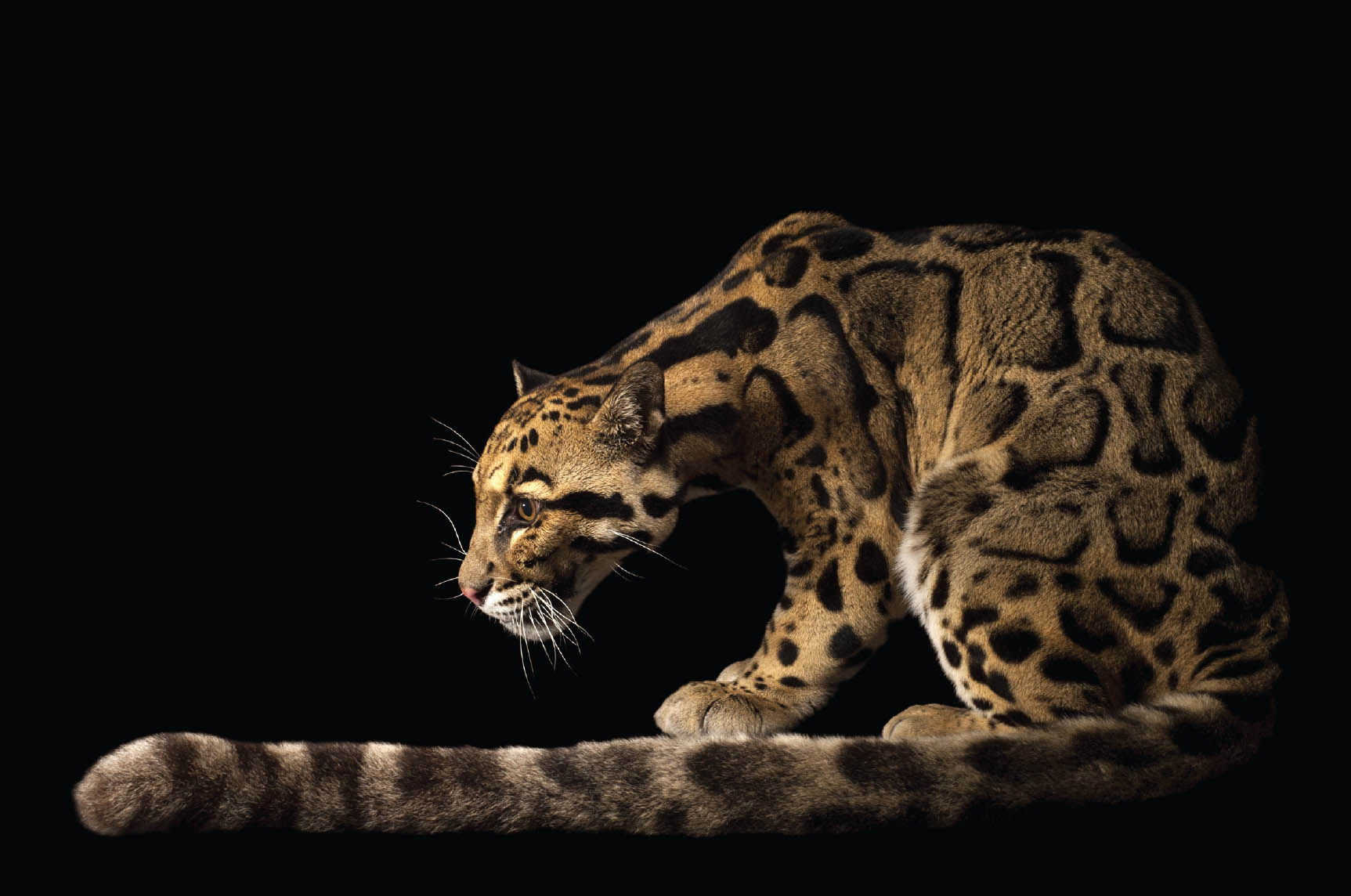
A clouded leopard at the Houston Zoo, Texas, USA. This species is a great climber and spends a good deal of its time in trees hunting and resting. Whether up high in the canopy or on the forest floor, the striking pattern of its coat yields great camouflage in the Asian forests it calls home.
Today, we human beings are the ones that hold earth’s fate in our hands. We really do need to pay attention and look these animals in the eye. Hopefully then people will decide whether or not the future of life on earth is worth it. If we don’t start paying attention to something other than politics, who won the ball game and the price of fuel, we will just stare into our phones all the way down and that will be it.
It’s imperative that people get smart enough, quick enough, to realize that when we save these other species, we’re actually saving ourselves. People are so distracted now that conservation work must be really engaging in order to pull them into the tent and teach all the great things they can do.
Everybody wants to view themselves as a good person; so let’s teach what folks can do to help save the planet. Really easy, simple, smart things that will put money in your pocket. Being green is profitable. If we can teach that, we’ve got it.
*
‘Figure out something you’re very passionate about that will make your own backyard or town a better place, then become an expert and spend years doing that one thing. After all, at the end of your days, in your declining hours, don’t you want to look in a mirror and smile, knowing that you did everything that you could while you were here?’
Not very long ago we humans were up in the trees on the plains of Africa. It was all about survival for most of the world’s people then and it’s still about survival today. We’re driven by greed and fear: ‘If I don’t get it, somebody else will’ and we’re afraid if we don’t grab all we can, we’ll fail and starve and die.
We are hardwired to be very aggressive and ‘go for it’, all the time, at all costs. That is not a generational thing, that is a human thing. We care about ourselves first – to survive, breed, procreate, pass on our genetics and we are a very successful species in that way. We’re thriving and not going down in number – but it’s at a great cost to the planet. How do we change that in time? I don’t know if it’s possible. I hope so. I wish that people would get smarter and show some kindness to each other and to the animals and plants around us.
Years ago, I asked a philanthropist why he didn’t contribute more to conservation. He was doing a lot of work around the world, giving money to villagers to help them learn better farming techniques, develop their wells and build schools. He said, ‘I actually am funding conservation. I know people will take every last animal and plant if they don’t have a stable way of life. If they don’t feel secure in their living, they will go and extract all the natural resources.’
So as I go through life and meet people, I listen to them and I learn. Until the human population settles down and feels comfortable with their standard of living, we are going to continue to lose wild places and wildlife at alarming rates. That’s the number one thing: trying to stabilize economies while slowing explosive exponential population growth. Perhaps then we can feed the people we already have. If we cannot do this, the only other animals to survive will be those that are super-adaptive to humans and thrive no matter what. As [scientist and author] David Quammen once put it, we will end up with a ‘Planet of Weeds’.
The main issue that I see is that we need vast blocks of habitat saved now, in order to stabilize our world. If you cut down all the trees along the equator, all the rainforests, you’re going to disrupt the rainfall cycle that provides us with the rain we need to grow crops. That’s our bread and butter. We have to stabilize the earth’s entire environment and that means big chunks of every natural system must be saved; the ocean, prairies, tundra, alpine zones, mangrove swamps, all of it, along with eliminating fossil fuel use, recycling everything – the works. It’s all tied in together – slow down on consumption, on overpopulation, all these things. One immediate concern is that we don’t allow the Amazon to be cut and burned down. If we allow that to happen, we won’t make it. And not just there – Gabon, Congo, all these places that still have great belts of rainforest that stabilize rainfall – those forests have to be protected too.

A critically endangered grey-shanked douc langur at the Endangered Primate Rescue Center in Cuc Phuong National Park, Vietnam. To make their Photo Ark portrait, the photographer and his team used a cage that the animals were accustomed to entering for transfers and converted it to a small ‘set’ using black and white backgrounds.
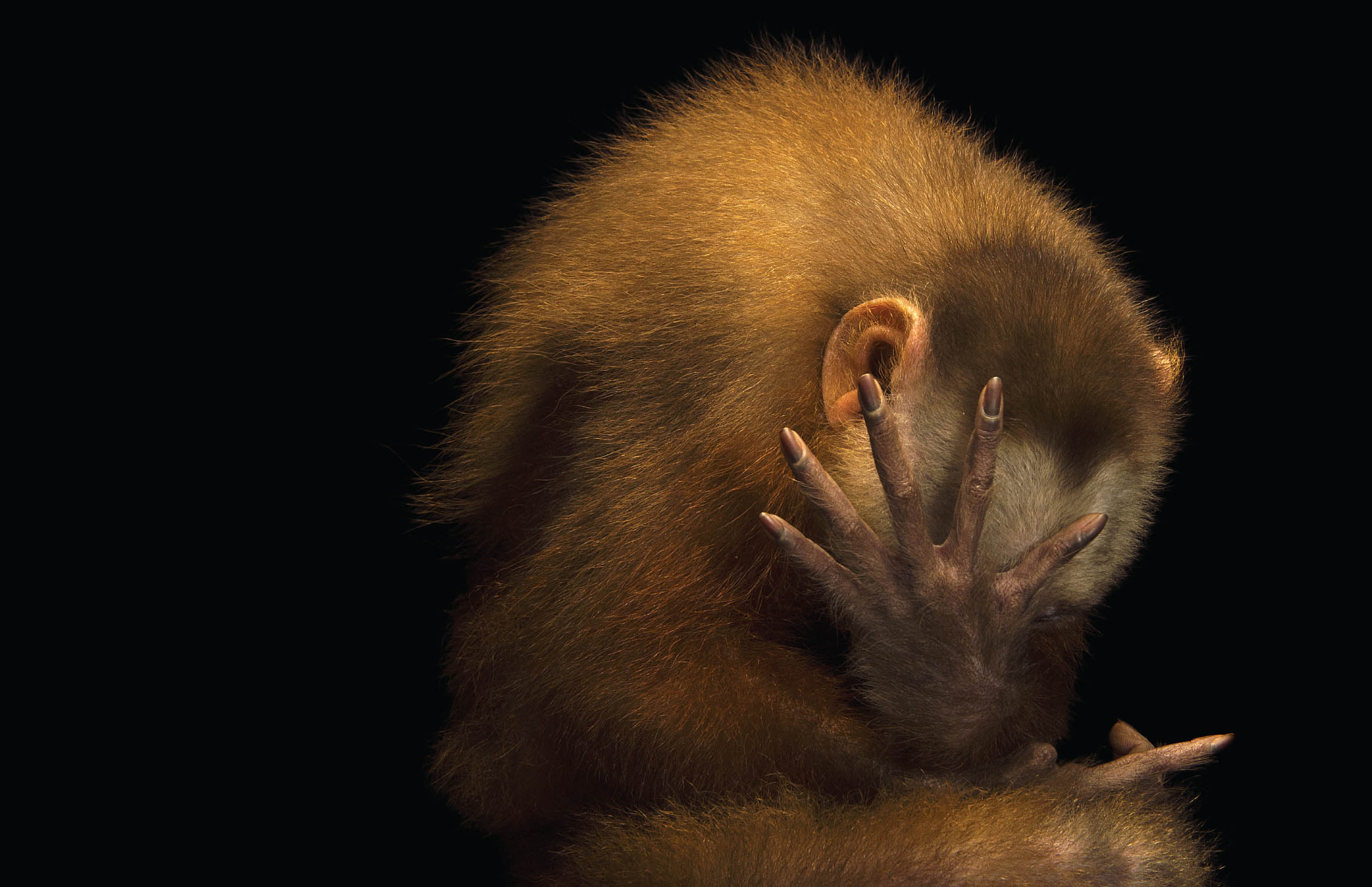
An endangered white-fronted capuchin at the Summit Municipal Park in Gamboa, Panama. Though he appears to be shy and avoiding the limelight, he’s actually munching on a banana. Keepers often use food as incentives to shift animals into perfect positions during Photo Ark sessions.
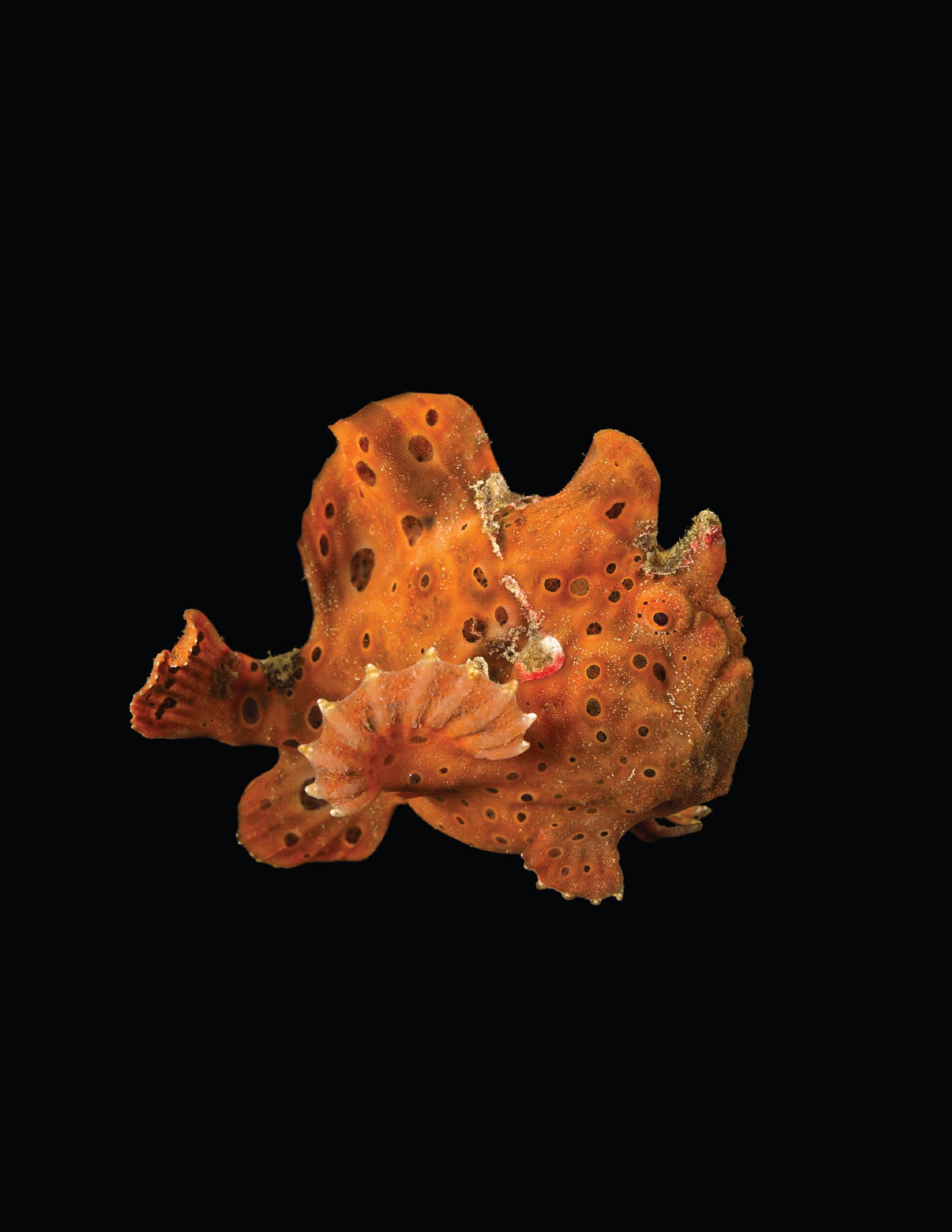
A painted frogfish at Henry Doorly Zoo and Aquarium in Omaha, Nebraska, USA. Though this animal stands out when in the open, he blends in perfectly when resting in coral of the same colour, allowing him to both ambush prey and hide from predators.
But we humans are so warlike, if we don’t have something to fight about, we’ll make it up. That’s why sports and politics are so popular, it’s controlled warfare. We’re just primates, fighting it out. But we must learn to rise above our nature and quickly. We must get smart enough and fast enough to realize that it is at our peril if we ignore what these species are saying.
A lot of people don’t think very far ahead. They have a, ‘We’ll be dead by then’ mentality. That’s not a plan. It’s not even trying. I often use this analogy when people ask me, ‘What good is that little frog that’s gone extinct. Who cares?’ I say, ‘Well think of it this way: If you were flying on an airplane over the ocean and you looked out your window and you saw a rivet coming loose on the wing, you’d probably go back to reading your magazine. But if you saw a bunch of rivets popping off the wing, you’d get a little sweaty. You’d tell the flight attendant and you’d start looking for a parachute if it got bad enough’. Well there isn’t a parachute for this.
Since we can’t get off this planet, we’d better start making sure that we don’t lose more species, because we don’t know where the point is at which we have catastrophic failure for a main grain or other food source. You don’t want the wings coming off, ever. It’s just basic. But even when I use that analogy, it doesn’t really register with people, even though I’m seeing the rivets working loose out of the wing every week – hundreds and hundreds of species on the cusp of extinction. It can really get unsettling. Sometimes it’s a little tough to sleep at night. But I don’t ever get depressed; I just think, ‘We’re going to use this species as an example, we’re going to teach with it, tell its story and let people know that this doesn’t have to happen.’ And I also know that most of the species you see in the Photo Ark can be saved at this point in time. That’s what the Photo Ark is about: mobilizing people to action, now. We need to save the ship while we still can.
*
I work with animals in human care and that means zoos, aquariums, private breeders, wildlife rehabbers and, occasionally, nature centres. These places are literally the arks now, especially zoos and aquariums. They have species that are gone from the wild, so if they quit breeding them and sharing genetics with other zoos, these species would be completely gone. Zoos also do a tremendous amount with education. For an urban society that’s more and more confined to cities, zoos are the last place where you can go and see how a real wild animal moves, how it sounds. This is a big deal. When nature is restricted to some quaint notion on a smartphone, are we really going to step up and fight to save it?
‘If you cut down all the trees along the equator, all the rainforests, you’re going to disrupt the rainfall cycle that provides us with the rain we need to grow crops. That’s our bread and butter.’
‘If it’s between staying at home and watching TV, or getting out and trying to stop extinction, I don’t have much of a choice.’
I was with a fellow Geographic photographer Tim Laman (p. 194) years ago in Equatorial Guinea. We were being driven somewhere and I was griping about how bad things were. I’d just been to the bushmeat market where people were eating monkeys and he said, ‘Hey man, this is the best time to be in conservation. We can reach the world now with the Web. This is actually the golden era, there’s so much we can do.’ He was very excited about that. That conversation in the back of the car changed my mind. I thought, ‘You know what, it doesn’t do any good to just sit and complain. There are amazing opportunities. We can speak directly to the public.’ And we do, all the time. Geographic’s got one hundred and thirty million people following its Instagram feed. That’s the power to save species, right now, like never before. I’m really hopeful. Besides, it doesn’t pay to be otherwise, does it?
I want to share my excitement with others and also get feedback as well, which we now can thanks to the internet. We can see what people react to; what they like; what moves them. They’re not motivated by insects or snakes, but they do like animals that appear to smile, like dolphins and primates. I even have a photograph of a turtle that looks like he’s smiling. People are drawn to animals that are anthropomorphic; that look like us. We actually had a PhD student study Photo Ark pictures and rate people’s responses. If an animal is down on the ground it doesn’t register at all, but if they’re sitting up that’s better. And if they’re standing, that’s something we human primates view with more respect, or at least pay more attention to. So if they stand up, they’ve got big eyes and they’re a furry mammal – now we’re talking! This is the way to get the world’s attention.
*
People ask me what my favourite animal is and I say, ‘The next one’, because I have to care about them all, whether they’re insects or polar bears. But a few that have really resonated with me are animals that are very close to extinction, like the northern white rhino named Nabire that I photographed at the Dvůr Králové Zoo in the Czech Republic. At the time, she was one of five left and now there are only two: a mother and her daughter in a pen in Kenya. That’s it. At the time, Nabire was very old and tired; she had fluid-filled cysts and they couldn’t anesthetize her to remove them because she wouldn’t have been able to withstand the procedure. The zoo’s PR contact said, ‘I’m glad you’re here now, because if you had waited another little while, she’s probably not going to make it.’ We did our shoot and she was very sweet. The keeper, who had raised her from a baby, broomed forage for her in the centre of our black set and she ate, then she lay down, took a nap and I think a week or ten days later one of those cysts in her burst and she passed away.

Two koala joeys cling to each other, waiting to be placed with human caregivers at the Australia Zoo Wildlife Hospital in Queensland, Australia. As juveniles, baby koalas need a lot of attention and emotional support, which is given to them by a network of people who run authorized foster homes. Once they’re old enough, the koalas will be released into the wild.

An Edward’s fig parrot at Loro Parque Fundación, Tenerife, Spain. Known as one of the most striking of all parrots due to their colourful facial feathers, this species is one of many being bred by the Loro Parque Fundación, one of the largest parrot breeding programmes in the world.
Then there was Toughie, the Rabbs’ fringe-limbed tree frog. He was the last one, from Panama. They were wiped out by chytrid fungus, which is an amphibian-killing disease that’s spreading around the world. Toughie was living in a little trailer in the parking lot at the Atlanta Botanical Garden in a ‘frog pod’, which is an isolation chamber so they couldn’t get sick. But he eventually died of old age. I went and photographed him two or three times and I show that frog everywhere I go; he’s even been projected on the side of the Vatican. I’m just trying to convince people that all species matter, no matter how small. When I look extinction in the eye like that, I think, ‘This is epic in ways I don’t understand and it’s going to eventually have very drastic consequences for humanity’. It’s like I’m a guy standing at the edge of a bridge that’s out, waving my hands. I’m seeing car after car go over. Eventually they’ll stop and listen, won’t they? So I’m fired up every day to get up, get out and get it done.
*
When I was a field photographer for National Geographic, one of my first stories was on America’s Gulf Coast, which is 1,800 miles [2,900 kilometres] long from south Florida to south Texas and rings the Gulf of Mexico. I spent twenty-seven weeks on that coast. In Florida I saw a mosquito control team fly big airplanes spraying insecticide mixed with diesel fuel all over the marshes and housing developments. But it didn’t just kill the mosquitos as it was intended to; it killed the butterflies, the beetles, the bees – everything. I thought, ‘That’s not right’. Next I went over to Galveston Bay. My wife had come down to see me and we walked on the beach. The bottoms of our feet turned black with spilled oil – tar – and we saw medical waste like hypodermic needles, blood bags, I.V. lines, used diapers and nylon rope. We came across a dead dolphin tangled up in fishing net. It was so depressing. Then we took a boat tour up the Houston Ship Channel and I thought I saw something moving in the water. The captain said, ‘Son, I’ve been running this boat up and down this channel for seven years and I’ve never seen anything alive in this water.’ It’s the region where the US turns oil into gasoline. I saw things like that over and over again on that story.
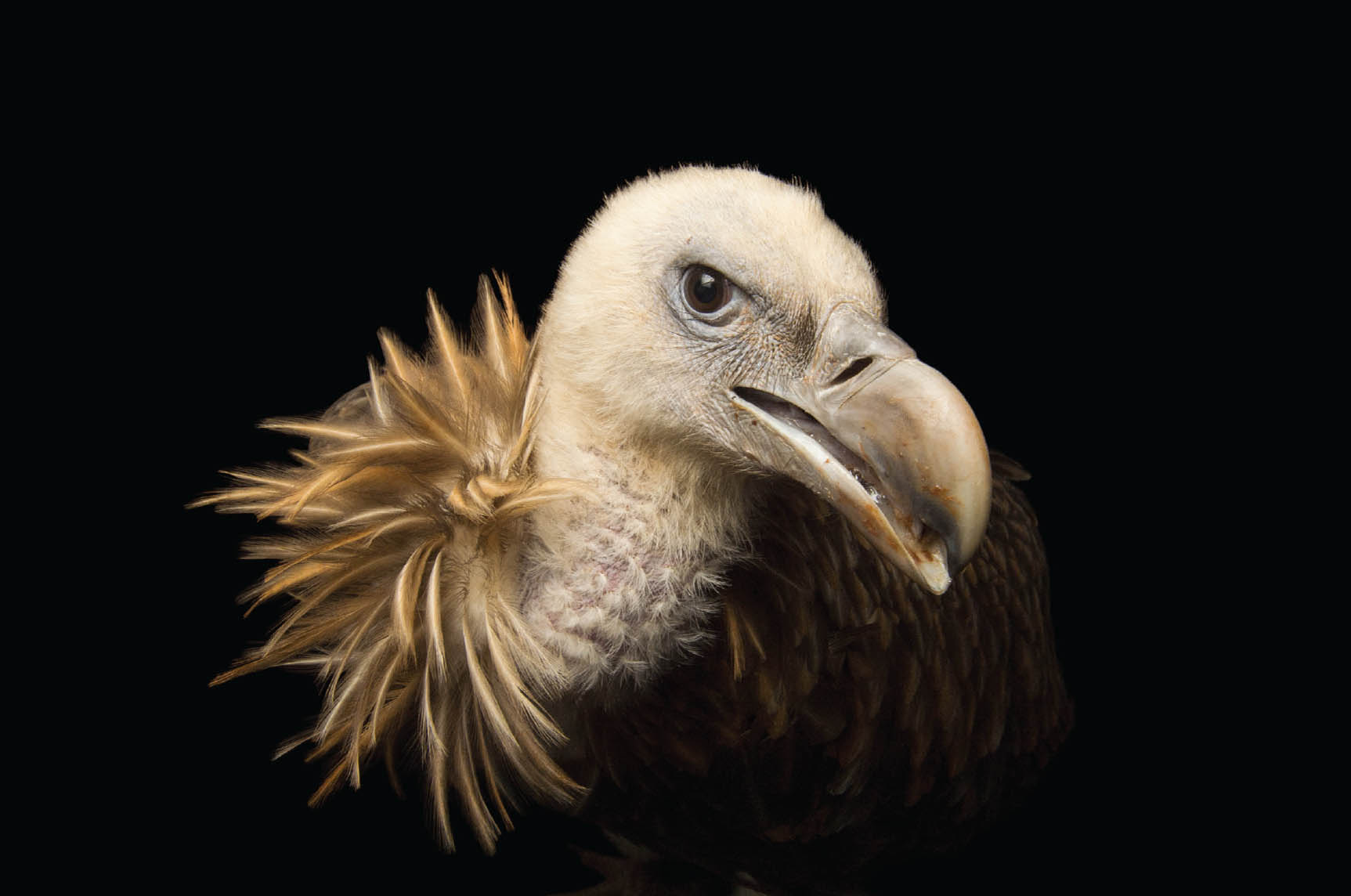
A Himalayan griffon vulture at the Assam State Zoo-cum-Botanical Garden in Guwahati, Assam, India. In the wild, this bird lives at higher altitudes and is among the largest of the old-world vultures.
In my travels, I’ve seen too much to let it go; people eating everything, even bats and spiders. People cutting down woods on really steep slopes that will only be productive as farm ground for about a year. I’ve seen plastic garbage everywhere, especially in the oceans and along waterways. And air pollution so thick people are wearing masks and still getting sick.
People think they’ve got to wait for an election year to vote and change things, but actually we’re voting every day. Every time you break out your purse, your wallet, your credit card, you’re voting. That’s the power to change the world, right there. Your money is either tearing the world down or building it up. What are you buying? Are you buying things made out of palm oil that’s produced unsustainably? Are you buying a bedroom set made out of carved hardwood from the Amazon? And how much fuel are you burning? Are you driving around a big SUV by yourself in an area that never gets snow or ice? Think about the stuff that you consume. Eat less meat – it takes a lot of water, chemicals and fossil fuel to produce. Yes, eat organic, but don’t pour insecticide and fungicide all over your lawn and then wonder why you don’t have vegetables that are any good. Support initiatives that get us off of fossil fuels and stop thinking about getting ‘more, more, more’ all the time. These are the things that people have to overcome if we want to survive.
At the end of the day, when people are gone and the pressure is taken off the landscape, nature will come roaring back. But it will be in a very different complement of species, climate patterns, the works. We can’t afford to be the ‘earth-eaters’ anymore. We have to be thoughtful for a change. I think that’s finally dawning on us, but it’s a race to see if we can turn things around in time. Will we get smart enough, fast enough?
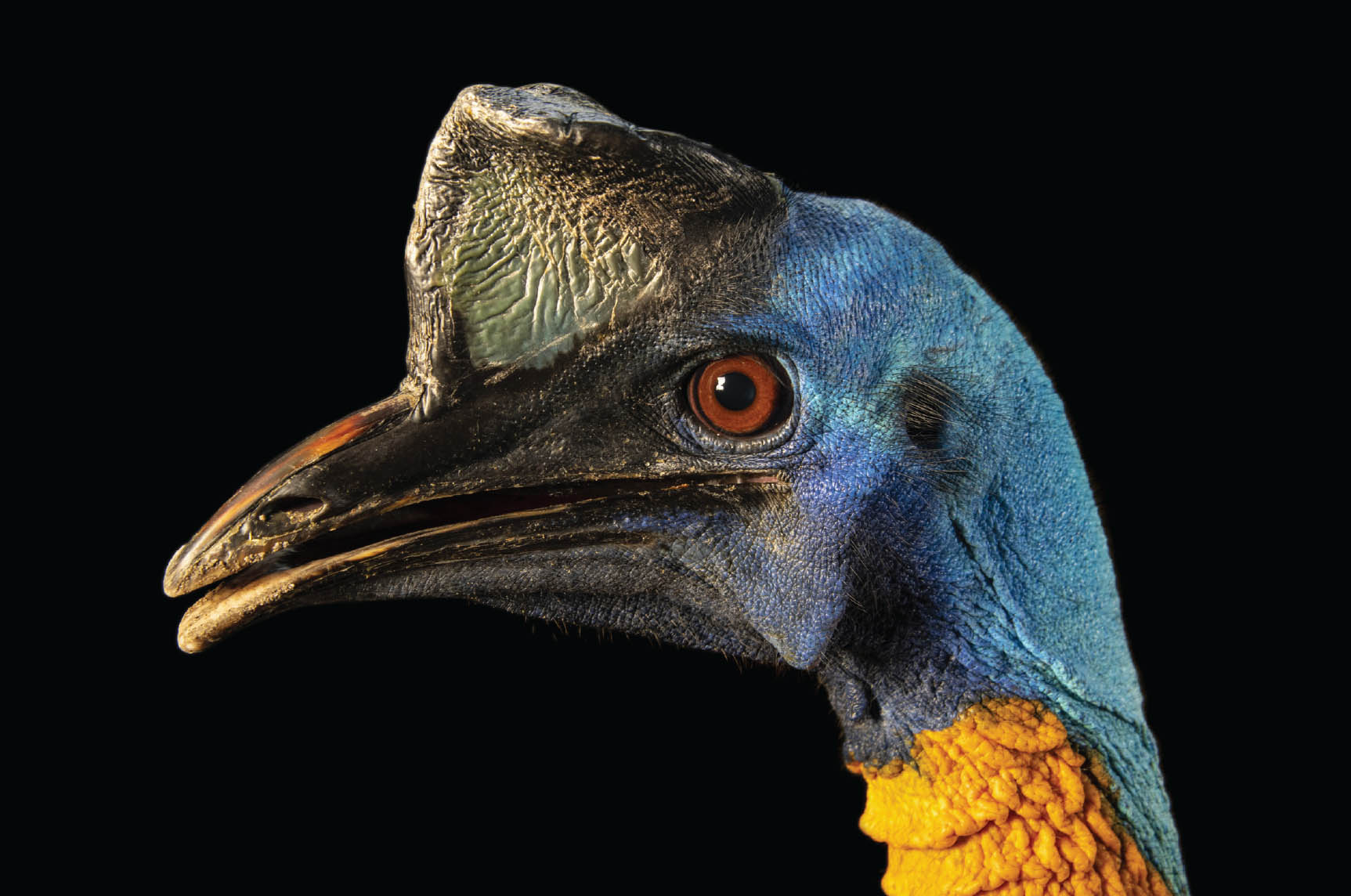
A single-wattled cassowary at Avilon Zoo in Rodriguez, the Philippines. Though this bird was completely calm, cassowaries are known to ward off threats by jumping up and using their large claws to fend off and even kill predators.
Right now, half of our country [USA] is facing off against the other half of the country and we’re not moving, we’re just howling against each other. We are not going to make any progress if we spend all our time fighting and hating. The solutions we need to save the planet [and ourselves] will have to be on a scale unlike anything we’ve done before. We all need to move in the same direction. And I hope that direction is, ‘Let’s consume less and only buy sustainable products. Let’s have renewable energy that doesn’t throw tons of carbon into the air daily.’ Unless we apply ourselves, we’re going to heat the planet and disrupt everything: rainfall, temperature, disease. And don’t forget the mass movement of people that will occur, because most live near coasts that are going to become flooded as sea levels rise. Even if you don’t fully believe in human-made climate change, wouldn’t you want to hedge your bets a little bit? Wouldn’t you want to be safe?
When it reaches crisis point then everybody will be beating down the doors of Parliament and Congress yelling, ‘Why didn’t you do something to save us?’ Well, because nobody was interested. Our presidential debates haven’t included questions asked about the environment for years. Nobody cares.
‘Every time you break out your purse or your wallet, your credit card, you’re voting. That’s the power to change the world, right there. Your money’s either tearing the world down or building it up.’
‘What’s the money for? You can only drive one car at a time, fly on one jet at a time, eat one meal at a time. What are you going to do with the rest of it?’
But they better start paying attention. It will take the right leadership at the right time and I don’t know if we are there yet in terms of being nervous enough to want to change. I can see why some politicians are popular; they say, ‘Let the good times roll. There are no problems, buy as big a car as you want, burn as much fuel as you want, do whatever you want.’ On the other extreme, a few politicians are saying, ‘No, austerity is the way forward’. I don’t think either of those approaches is going to work, to be honest. We have to convince people that it’s fun to be green. It’s also profitable to save the planet. And it’s very satisfying.
I always tell people to specialize, figure out something you’re very passionate about that will make your own backyard or town a better place, then become an expert and spend years doing that one thing. After all, at the end of your days, in your declining hours, don’t you want to look in a mirror and smile, knowing that you did everything that you could while you were here?
*
Every time I go out on photo shoots, I meet conservation heroes who are doing all they can. I’ll give you a couple of examples: one is a guy named Tilo Nadler, founder of the Endangered Primate Rescue Center (EPRC), which was the first wildlife rehabilitation centre in Vietnam. He was an electronics engineer who went to Vietnam in the early 1990s on vacation. He quickly saw there was a problem with baby primates being confiscated from poachers by the government; there was no place to put them, so they were being euthanized. He told me, ‘It wasn’t what I did, it wasn’t what I knew how to do – but I couldn’t let them do this.’ So he started EPRC in the north of Vietnam and he and his team saved two species of primate from extinction: the Delacour’s langur and the Cat Ba or white-headed langur. He now has populations of these langurs, plus gibbons, in big outdoor enclosures eating native vegetation, thriving and breeding. Tilo started all this at an age where he knew he’d never live to see the day when these animals could actually all be set free without still facing poachers. He founded that centre because it was the right thing to do, regardless of what it would take in terms of funding or personal sacrifice – he actually moved to Vietnam from Germany. That, to me, is the true measure of him, to know you’re likely not going to see the payoff, but you are going to do it anyway. It’s like planting a fruit tree when you are a hundred years old. I’ve never met anybody that went into conservation that regretted it. That heartens me.
I rode an elevator recently after I’d spoken to a group of financial advisors – big money guys that did nothing but think about ways to get more money added to the top of the big piles of money they’d already amassed – and in the elevator they said, ‘Well, we all feel worthless now, Joel, thanks.’ I said, ‘Well you shouldn’t, because you actually can change the world. The conservationists I speak to don’t have two nickels to their name. You guys have the power to start investing in green funding and to say no to things that are terrible environmentally. You don’t have to invest in those types of destructive industries anymore.’ And maybe in that little elevator ride from sixth floor down to first floor, the light came on above a couple of their heads. I hope so. What’s the money for? You can only drive one car at a time, fly on one jet at a time, eat one meal at a time. What are you going to do with the rest of it? Try to grow your company and make profit? To make more profit?

A mossy leaf-tailed gecko at the Henry Doorly Zoo and Aquarium in Omaha, Nebraska, USA. Though easy to see against a plain black background, this animal would be virtually impossible to spot when at rest on a lichen-covered rock or tree with similar colour patterns. Note that nearly every edge of its body is serrated, which camouflages even its shadow.
‘We must have nature; it does not need us.’
There’s got to be a higher ideal. I’m greatly encouraged by the nearly two hundred Fortune 500 company leaders who recently took an ethics pledge that said, ‘We’re not just going to think about the bottom line, we’re going to think about the societal and environmental costs of our actions.’8 That is HUGE. When I started in photography, companies didn’t even have to pretend to be green, so we’ve come a long way. But true change is generational – twenty, twenty-five years. How many of those twenty to twenty-five-year blocks do we have left before the wheels really come off of the environment? And that’s the whole ballgame; nature keeps our planet stable. We must have nature; it does not need us.

An endangered baby Bornean orangutan named Aurora, with her adoptive mother, Cheyenne, a Bornean-Sumatran cross at the Houston Zoo, Texas, USA. When the baby’s biological mother wouldn’t feed Aurora anymore, Cheyenne indicated to keepers that she would like to care for her. Cheyenne turned out to be a very good mother and Aurora grew up happy and healthy.

















